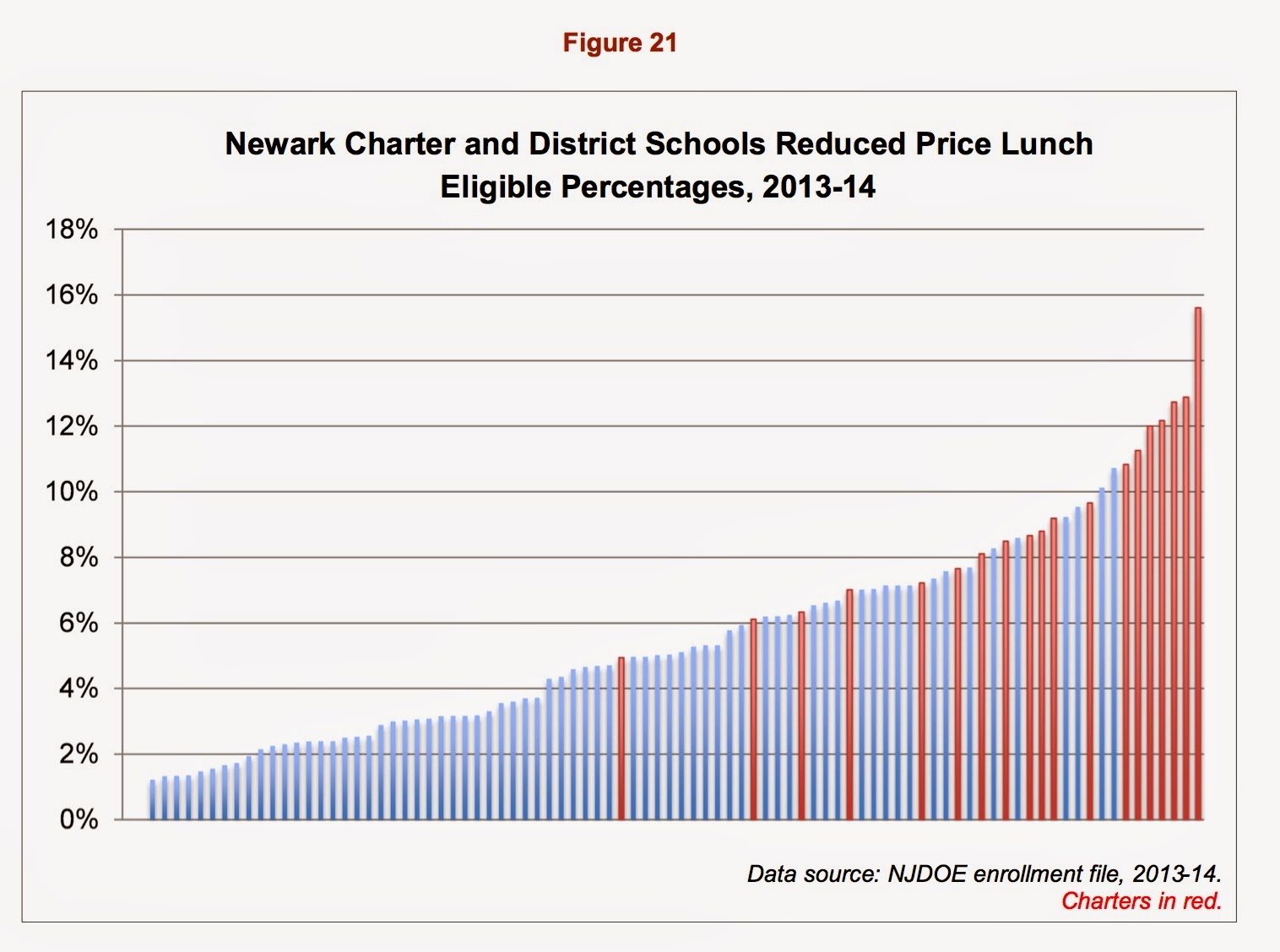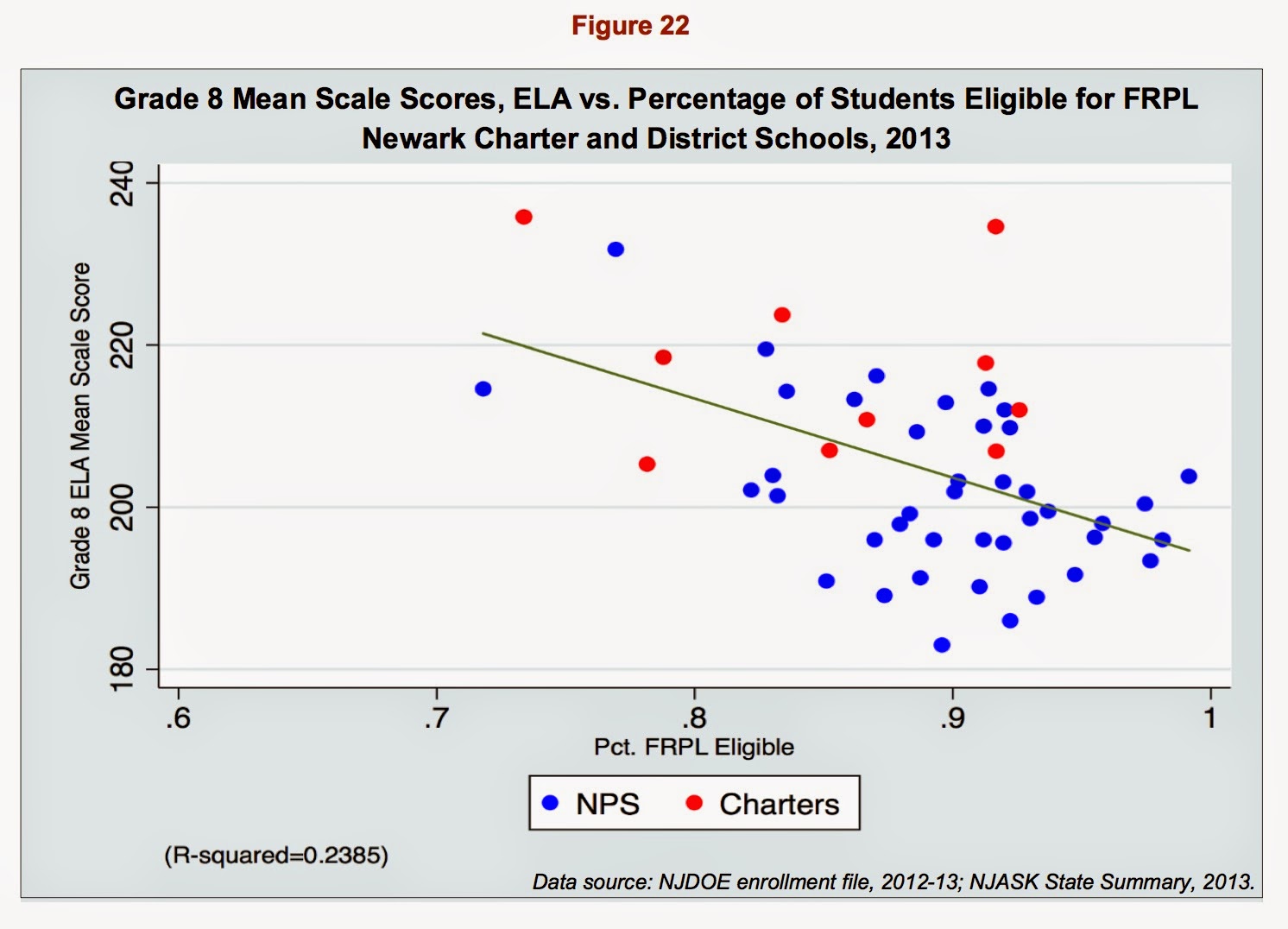Jersey Jazzman: Charter Schools: Why Poverty Measures Matter
What I'm going to say in this post is important.
Yes, it's quanty and it has scary graphs and stuff, but I'm going to ask you to trust me and stay until the end. Because if you care about education policy, and if you care about the debate over school "choice," you must understand what I'm trying to say here.
All of the graphs are from my new report on New Jersey's charter schools. The data is publicly available and replicable.
People smarter about the numbers than I am have tried to make the same point I'm going to make here -- apparently without luck. I don't know if that's because certain reformy types can't understand what follows, or because they won't. From my perspective, anyone willing to think a little can get this, so there really is "no excuse" (heh) for not comprehending this critical point of policy.
Ready?
Let's suppose you live in Newark, NJ, one of the most economically disadvantaged communities in the nation. You're a single parent of three children. You're offered two jobs, each doing equal work. One pays $30,615 a year; one pays $43,568.
Which job will you take? Obviously, the higher paying one. Understand, you are still going to have a tough time of it: it is very, very hard to raise a family of four in the metro New York area on a little more than $40 thousand a year. But it's even harder to raise that same family on $30 thousand. In a city like Newark, where the majority of families are living in economic disadvantage, making $43,568 is a sign of relative advantage compared to the much of the rest of the city.
Certainly, you're not advantaged compared to the families in Millburn or Montclair, and any assistance you can get will be very helpful. But again: compared to much of the rest of Newark, you are doing relatively better.
Now, it turns out that we have a measure of economic disadvantage that distinguishes families living in relative levels of economic disadvantage. The National School Lunch Program is available to families based on their relative need. If your family is living at 130 percent or below the poverty line -- for a family of four, that's $30,615 a year -- your children qualify for free lunch. If your family is between 130 and 185 percent of the poverty line -- that's between $30,615 and $43,568 for that same family of four -- your children qualify for reduced-price lunch.
This is not a perfect measure of poverty, and there are only three levels: free lunch eligible (FL), reduced-price lunch eligible (RPL), and not eligible. But it's the best measure of student economic disadvantage we've got, and it's actually not nearly as bad as many people make it out to be.
Here's how we should think about these three levels:
FL < RPL < Not Eligible
Certainly, RPL is a worse state of economic disadvantage than Not Eligible. But it's not as bad FL. In a community where almost everyone qualifies for FL or RPL, RPL is a sign of relative economic advantage.
Anyone who thinks this statement is in any way controversial or denigrating is missing the point -- in my opinion, willingly missing the point, because it is such an easy concept to grasp. Yes, families who qualify for RPL are certainly struggling. But they aren't struggling nearly as much as families who qualify for FL. Can we all agree on this?
Good. Now let's look at Newark's schools -- charters and districts -- keeping all of the above in mind. The first graph will look at each school's population of children who qualify for either FL or RPL. District schools are blue, and charters are red:
You'll notice a few schools with relatively low concentrations of FL or RPL (together, FRPL) students. But the majority of schools in Newark have populations where at least 70 percent of the students qualify for FRPL; a sizable majority of schools have at least 80 percent FRPL. This is a community where many, many families live in economic disadvantage.
But, again, some families are struggling more than others. Here are the schools by FL percentage; again, that's 130% of the poverty line or below:
It's because Newark's charters serve relatively more students who are eligible for reduced-price lunch.
See how the red lines are all clustered at the top end (notice, also, how the y-axis has changed; this is a relative difference in RPL concentrations). The charter sector in Newark serves more RPL students proportionately than the district schools. Again, I'm not saying these students aren't living in economic disadvantage -- they are. But relative to the rest of Newark, these students are better off.
Now that we've established these facts, let's explore why they might matter. As everyone knows, student population characteristics affect test scores. When a school enrolls greater numbers of children who qualify for free or reduced-price lunch, they are very likely going to have lower test scores compared to a school that enrolls fewer of those children. Here's an example from Newark, using scores on the Grade 8 English Language Arts exam:
See how as the percentage of students who qualify for FRPL goes up, the average test score for the school goes down. Yes, there's some variation, but the pattern is fairly well established.
But let's look now at just the FL rate and test scores:
 You'll notice the pattern remains the same, but the dots are "tighter" to the trend line in the middle of the graph. Statistically, half of the variation in test scores can be explained by FL rates. That's stronger than the correlation above, so right away, we have a clue: in a community with large numbers of students in economic disadvantage, FL explains more of the variation in test scores than FRPL.
You'll notice the pattern remains the same, but the dots are "tighter" to the trend line in the middle of the graph. Statistically, half of the variation in test scores can be explained by FL rates. That's stronger than the correlation above, so right away, we have a clue: in a community with large numbers of students in economic disadvantage, FL explains more of the variation in test scores than FRPL.
But let's take it one step further. How does RPL affect test scores?
 Whoa! When we looked at FL and FRPL, test scores when down when the rate went up. But look at this -- we've flipped the relationship! In a community like Newark, when RPL rates go up, test scores go up!
Whoa! When we looked at FL and FRPL, test scores when down when the rate went up. But look at this -- we've flipped the relationship! In a community like Newark, when RPL rates go up, test scores go up!
Keep in mind that this is a relationship we'll only see if we limit our sample size to a community like Newark. If we tried to do this across the state, we wouldn't see the same relationship: that's because, relative to the entire state, RPL is a measure of economic disadvantage.
But when we limit our framework to Newark only, the relationship changes. Why? Because in Newark, RPL is a sign of relative economic advantage, not disadvantage.
Again: the charter schools in Newark enroll more RPL students than the districts. This gives them an advantage on test scores, not a disadvantage, when compared to other schools in the city. And that's why, when comparing charter schools within the city, we shouldn't use a combination of FL and RPL to measure economic disadvantage. We're much better off using FL alone: it's a better predictor, because compared to FRPL, it's the measure with more variation.
Look, I understand this stuff makes some people's heads swim, but it's really important to get it right. You can't just ignore it by saying: "Well, the charters are serving lots of kids whose families are struggling!" No one is saying they aren't; what I'm saying is that, given the data we have, we should be looking at these measures appropriately. And conflating FL with FRPL isn't appropriate.
So let's stop the spin, please. We have an issue here and it needs to be addressed clearly and honestly. Can't we all agree on this? If so, I'll agree to drop the snark.
If not...
That's all I have to say on the blog about the charter report. There are two more parts to come; I'll pick up this conversation when they are released later this year.
This blog post has been shared by permission from the author.
Readers wishing to comment on the content are encouraged to do so via the link to the original post.
Find the original post here:
The views expressed by the blogger are not necessarily those of NEPC.




